Spatiotemporal Variations in Carbon Sources and Sinks in National Park Ecosystem and the Impact of Tourism
Abstract
1. Introduction
2. Materials and Methods
2.1. Study Area
2.2. NPP Product Data
2.3. Estimation of NEP
2.4. GeoDetector
3. Results
3.1. Spatial and Temporal Changes in Ecosystem NEP
3.1.1. Interannual Change
3.1.2. Seasonal Variation
3.2. Spatial Change
3.2.1. Vertical Variation
3.2.2. Horizontal Changes
3.3. Factor Detection
3.4. Interaction Factor Detection
4. Discussion
4.1. Effect of Natural Factors on NEP Changes
4.2. Effect of Human Activity Factors on NEP Changes
4.3. Interaction of Various Factors on NEP Changes
4.4. Impact Mechanism of Tourism on Ecosystem CSS
5. Conclusions
Supplementary Materials
Author Contributions
Funding
Data Availability Statement
Acknowledgments
Conflicts of Interest
References
- IPCC. Climate Change 2013: The Physical Science Basis. In Contribution of Working Group I to the Fifth Assessment Report of the Intergovernmental Panel on Climate Change; Cambridge University Press: Cambridge, UK; New York, NY, USA, 2013. [Google Scholar]
- Friedlingstein, P.; Jones, M.W.; O’Sullivan, M.; Andrew, R.M.; Bakker, D.C.E.; Hauck, J.; Quéré, C.L.; Peters, G.P.; Peters, W.; Pongratz, J.; et al. Global Carbon Budget 2021. Earth Syst. Sci. Data 2022, 14, 1917–2005. [Google Scholar] [CrossRef]
- Li, B.; Gasser, T.; Ciais, P.; Piao, S.; Tao, S.; Balkanski, Y.; Hauglustaine, D.; Boisier, J.P.; Chen, Z.; Huang, M.; et al. The contribution of China’s emissions to global climate forcing. Nature 2016, 531, 357–361. [Google Scholar] [CrossRef] [PubMed]
- Fu, B.; Li, B.; Gasser, T.; Tao, S.; Ciais, P.; Piao, S.; Balkanski, Y.; Li, W.; Yin, T.; Han, L.; et al. The contributions of individual countries and regions to the global radiative forcing. Proc. Natl. Acad. Sci. USA 2021, 118, e2018211118. [Google Scholar] [CrossRef] [PubMed]
- Piao, S.; He, Y.; Wang, X.; Chen, F. Estimation of China’s terrestrial ecosystem carbon sink: Methods, progress and prospects. Sci. China-Earth Sci. 2022, 65, 641–651. [Google Scholar] [CrossRef]
- Wang, J.; Feng, L.; Palmer, P.I.; Liu, Y.; Fang, S.; Bösch, H.; O’Dell, C.W.; Tang, X.; Yang, D.; Liu, L.; et al. Large Chinese land carbon sink estimated from atmospheric carbon dioxide data. Nature 2020, 586, 720–723. [Google Scholar] [CrossRef]
- Xu, L.; Yu, G.; He, N. Increased soil organic carbon storage in Chinese terrestrial ecosystems from the 1980s to the 2010s. J. Geogr. Sci. 2019, 29, 49–66. [Google Scholar] [CrossRef]
- Fernández-Martínez, M.; Sardans, J.; Chevallier, F.; Ciais, P.; Obersteiner, M.; Vicca, S.; Canadell, J.G.; Bastos, A.; Friedlingstein, P.; Sitch, S.; et al. Global trends in carbon sinks and their relationships with CO2 and temperature. Nat. Clim. Chang. 2019, 9, 73–79. [Google Scholar] [CrossRef]
- Baldocchi, D.D. How eddy covariance flux measurements have contributed to our understanding of Global Change Biology. Glob. Chang. Biol. 2020, 26, 242–260. [Google Scholar] [CrossRef]
- He, H.; Wang, S.; Zhang, L.; Wang, J.; Ren, X.; Zhou, L.; Piao, S.; Yan, H.; Ju, W.; Gu, F.; et al. Altered trends in carbon uptake in China’s terrestrial ecosystems under the enhanced summer monsoon and warming hiatus. Natl. Sci. Rev. 2019, 6, 135–144. [Google Scholar] [CrossRef]
- He, W.; Jiang, F.; Ju, W.; Chevallier, F.; Baker, D.F.; Wang, J.; Wu, M.; Johnson, M.S.; Philip, S.; Wang, H.; et al. Improved constraints on the recent terrestrial carbon sink over China by assimilating OCO-2 XCO2 retrievals. J. Geophys. Res. Atmos. 2023, 128, e2022JD037773. [Google Scholar] [CrossRef]
- Philip, S.; Johnson, M.S.; Baker, D.F.; Basu, S.; Tiwari, Y.K.; Indira, N.K.; Ramonet, M.; Poulter, B. OCO-2 satellite-imposed constraints on terrestrial biospheric CO2 fluxes over South Asia. J. Geophys. Res. Atmos. 2022, 127, e2021JD035035. [Google Scholar] [CrossRef]
- Woodwell, G.M. The carbon dioxide question. Sci. Am. 1978, 238, 34–43. [Google Scholar] [CrossRef]
- Chapin, F.S.; Woodwell, G.M.; Randerson, J.T.; Rastetter, E.B.; Lovett, G.M.; Baldocchi, D.D.; Clark, D.A.; Harmon, M.E.; Schimel, D.S.; Valentini, R.; et al. Reconciling carbon-cycle concepts, terminology, and methods. Ecosystems 2006, 9, 1041–1050. [Google Scholar] [CrossRef]
- Chuai, X.W.; Qi, X.X.; Zhang, X.Y.; Li, J.S.; Yuan, Y.; Guo, X.M.; Huang, X.J.; Park, S.; Zhao, R.Q.; Xie, X.L.; et al. Land degradation monitoring using terrestrial ecosystem carbon sinks/sources and their response to climate change in China. Land Degrad. Dev. 2018, 29, 3489–3502. [Google Scholar] [CrossRef]
- Ouyang, Z.; Zheng, H.; Xiao, Y.; Polasky, S.; Liu, J.; Xu, W.; Wang, Q.; Zhang, L.; Xiao, Y.; Rao, E.; et al. Improvements in ecosystem services from investments in natural capital. Science 2016, 352, 1455–1459. [Google Scholar] [CrossRef]
- Sun, B.F.; Zhao, H.; Lu, F.; Wang, X.K. Spatial and temporal patterns of carbon sequestration in the Northeastern Forest Regions and its impact factors analysis. Acta Ecol. Sin. 2018, 38, 4975–4983. [Google Scholar]
- Wan, W.; Liu, Z.; Li, J.H.; Xu, J.N.; Wu, H.Q.; Xu, Z.H. Spatiotemporal patterns of maize drought stress and their effects on biomass in the Northeast and North China Plain from 2000 to 2019. Agric. For. Meteorol. 2022, 315, 108821. [Google Scholar] [CrossRef]
- Yan, Y.C.; Liu, X.P.; Ou, J.P.; Li, X.; Wen, Y.Y. Assimilating multi-source remotely sensed data into a light use efficiency model for net primary productivity estimation. Int. J. Appl. Earth Obs. Geoinf. 2018, 72, 11–25. [Google Scholar] [CrossRef]
- Liu, Z.H.; Wang, T.; Qu, Y.H.; Liu, H.M.; Wu, X.F.; Wen, Y. Prediction of High-Quality MODIS-NPP Product Data. Remote Sens. 2019, 11, 1458. [Google Scholar] [CrossRef]
- Nemani, R.R.; Keeling, C.D.; Hashimoto, H.; Jolly, W.M.; Piper, S.C.; Tucker, C.J.; Myneni, R.B.; Running, S.W. Climate-driven increases in global terrestrial net primary production from 1982 to 1999. Science 2003, 300, 1560–1563. [Google Scholar] [CrossRef]
- Dong, S.; Du, S.; Wang, X.C.; Dong, X. Terrestrial vegetation carbon sink analysis and driving mechanism identification in the Qinghai-Tibet Plateau. J. Environ. Manag. 2024, 360, 121158. [Google Scholar] [CrossRef] [PubMed]
- Xia, B.; Ma, P.Y.; Xu, C.; Zhang, L. Spatiotemporal Variation of NPP and Its Response to Extreme Climate Indices in Yellow River Basin in Recent 20 Years. Res. Soil Water Conserv. 2023, 30, 256–266. [Google Scholar]
- Zhao, L.; Du, M.; Du, W.; Guo, J.; Liao, Z.; Kang, X.; Liu, Q. Evaluation of the Carbon Sink Capacity of the Proposed Kunlun Mountain National Park. Int. J. Environ. Res. Public Health 2022, 19, 9887. [Google Scholar] [CrossRef] [PubMed]
- Piao, S.L.; Yue, C.; Ding, J.Z.; Guo, Z.T. Perspectives on the role of terrestrial ecosystems in the ‘carbon neutrality’ strategy. Sci. China-Earth Sci. 2022, 65, 1178–1186. [Google Scholar] [CrossRef]
- Yang, Y.; Shi, Y.; Sun, W.; Chang, J.; Zhu, J.; Chen, L.; Wang, X.; Guo, Y.; Zhang, H.; Yu, L.; et al. Terrestrial carbon sinks in China and around the world and their contribution to carbon neutrality. Sci. China-Life Sci. 2022, 52, 534–574. [Google Scholar]
- Dai, E.F.; Huang, Y.; Wu, Z.; Zhao, D.S. Analysis of spatio-temporal features of a carbon source/sink and its relationship to climatic factors in the Inner Mongolia grassland ecosystem. J. Geogr. Sci. 2016, 26, 297–312. [Google Scholar] [CrossRef]
- Li, Z.; Chen, Y.N.; Zhang, Q.F.; Li, Y. Spatial patterns of vegetation carbon sinks and sources under water constraint in Central Asia. J. Hydrol. 2020, 590, 125355. [Google Scholar] [CrossRef]
- Liang, L.; Geng, D.; Yan, J.; Qiu, S.Y.; Shi, Y.Y.; Wang, S.G.; Wang, L.J.; Zhang, L.P.; Kang, J.R. Remote Sensing Estimation and Spatiotemporal Pattern Analysis of Terrestrial Net Ecosystem Productivity in China. Remote Sens. 2022, 14, 1902. [Google Scholar] [CrossRef]
- Wang, Q.H.; Zhang, Z.Q.; Qu, J.S. A Review of the Research on Household Carbon Emission. Adv. Earth Sci. 2013, 28, 1305–1312. [Google Scholar]
- Duffy, K.A.; Schwalm, C.R.; Arcus, V.L.; Koch, G.W.; Liang, L.Y.L.; Schipper, L.A. How close are we to the temperature tipping point of the terrestrial biosphere? Sci. Adv. 2021, 7, eaay1052. [Google Scholar] [CrossRef]
- Cao, H.; Wu, H.Z.; Shen, S.S.; Zhan, X.Y.; Yan, S.J. “National carbon source” or “national carbon sink”? Based on the carbon balance analysis of Wuyi Mountain National Park. J. Nat. Resour. 2023, 38, 934–950. [Google Scholar] [CrossRef]
- Peng, Q.; Wang, R.; Jiang, Y.; Li, C. Contributions of climate change and human activities to vegetation dynamics in Qilian Mountain National Park, northwest China. Glob. Ecol. Conserv. 2021, 32, e01947. [Google Scholar] [CrossRef]
- Dimobe, K.; Kuyah, S.; Dabré, Z.; Ouédraogo, A.; Thiombiano, A. Diversity-carbon stock relationship across vegetation types in W National park in Burkina Faso. For. Ecol. Manag. 2019, 438, 243–254. [Google Scholar] [CrossRef]
- Grossi, G.; Vitali, A.; Bernabucci, U.; Lacetera, N.; Nardone, A. Greenhouse Gas Emissions and Carbon Sinks of an Italian Natural Park. Front. Environ. Sci. 2021, 9, 706880. [Google Scholar] [CrossRef]
- Xue, L.F.; Luo, X.F.; Li, Z.L.; Wu, R.X. Spatial spillover effects and influencing factors of forest carbon sink in China: Spatial econometric analysis based on forest resources inventory in 31 provinces of the mainland of China. J. Nat. Resour. 2017, 32, 1744–1754. [Google Scholar]
- Xu, X.; Feng, C.; Droma, P.; Tan, Y. A carbon neutral account framework for the Qomolangma mountaineering tourism area. Environ. Dev. Sustain. 2023, 25, 14101–14130. [Google Scholar] [CrossRef]
- Lenzen, M.; Sun, Y.-Y.; Faturay, F.; Ting, Y.-P.; Geschke, A.; Malik, A. The carbon footprint of global tourism. Nat. Clim. Chang. 2018, 8, 522–528. [Google Scholar] [CrossRef]
- Scott, D.; Becken, S. Adapting to climate change and climate policy: Progress, problems and potentials. J. Sustain. Tour. 2010, 18, 283–295. [Google Scholar] [CrossRef]
- Sun, Y.-Y.; Cadarso, M.A.; Driml, S. Tourism carbon footprint inventories: A review of the environmentally extended input-output approach. Ann. Touris. Res. 2020, 82, 102928. [Google Scholar] [CrossRef]
- Zhang, J.; Zhang, Y. Carbon tax, tourism CO2 emissions and economic welfare. Ann. Touris. Res. 2018, 69, 18–30. [Google Scholar] [CrossRef]
- Paramati, S.R.; Alam, M.S.; Chen, C.-F. The Effects of Tourism on Economic Growth and CO2 Emissions: A Comparison between Developed and Developing Economies. J. Travel Res. 2016, 56, 712–724. [Google Scholar] [CrossRef]
- Nhamo, G.; Dube, K.; Chapungu, L.; Chikodzi, D. Quest for NetZero emissions in South African national parks: A tourism perspective. Heliyon 2023, 9, e16410. [Google Scholar] [CrossRef] [PubMed]
- Gou, R.; Li, W.; Yang, Y.; Bai, J.; Meng, Y.; Wu, J.; Ding, Y.; Dai, Z.; Shi, Q.; Song, S.; et al. Changes in Water Retention and Carbon Sequestration in the Huangshan UNESCO Global Geopark (China) from 2000 to 2015. Forests 2020, 11, 1152. [Google Scholar] [CrossRef]
- Leroux, L.; Bégué, A.; Lo Seen, D.; Jolivot, A.; Kayitakire, F. Driving forces of recent vegetation changes in the Sahel: Lessons learned from regional and local level analyses. Remote Sens. Environ. 2017, 191, 38–54. [Google Scholar] [CrossRef]
- Teng, M.J.; Zeng, L.X.; Hu, W.J.; Wang, P.C.; Yan, Z.G.; He, W.; Zhang, Y.; Huang, Z.L.; Xiao, W.F. The impacts of climate changes and human activities on net primary productivity vary across an ecotone zone in Northwest China. Sci. Total Environ. 2020, 714, 136691. [Google Scholar] [CrossRef]
- Zhang, J.J.; Hao, X.M.; Hao, H.C.; Fan, X.; Li, Y.H. Climate Change Decreased Net Ecosystem Productivity in the Arid Region of Central Asia. Remote Sens. 2021, 13, 4449. [Google Scholar] [CrossRef]
- Wang, J.F.; Zhang, T.L.; Fu, B.J. A measure of spatial stratified heterogeneity. Ecol. Indic. 2016, 67, 250–256. [Google Scholar] [CrossRef]
- Nie, T.; Dong, G.T.; Jiang, X.H.; Lei, Y.X. Spatio-Temporal Changes and Driving Forces of Vegetation Coverage on the Loess Plateau of Northern Shaanxi. Remote Sens. 2021, 13, 613. [Google Scholar] [CrossRef]
- Liu, C.L.; Li, W.L.; Wang, W.Y.; Zhou, H.K.; Liang, T.G.; Hou, F.J.; Xu, J.; Xue, P.F. Quantitative spatial analysis of vegetation dynamics and potential driving factors in a typical alpine region on the northeastern Tibetan Plateau using the Google Earth Engine. Catena 2021, 206, 105500. [Google Scholar] [CrossRef]
- Song, Y.Z.; Wang, J.F.; Ge, Y.; Xu, C.D. An optimal parameters-based geographical detector model enhances geographic characteristics of explanatory variables for spatial heterogeneity analysis: Cases with different types of spatial data. GISci. Remote Sens. 2020, 57, 593–610. [Google Scholar] [CrossRef]
- Wang, Y.M.; Zhang, Z.X.; Chen, X. Quantifying Influences of Natural and Anthropogenic Factors on Vegetation Changes Based on Geodetector: A Case Study in the Poyang Lake Basin, China. Remote Sens. 2021, 13, 5081. [Google Scholar] [CrossRef]
- Ahlström, A.; Raupach, M.R.; Schurgers, G.; Smith, B.; Arneth, A.; Jung, M.; Reichstein, M.; Canadell, J.G.; Friedlingstein, P.; Jain, A.K.; et al. The dominant role of semi-arid ecosystems in the trend and variability of the land CO2 sink. Science 2015, 348, 895–899. [Google Scholar] [CrossRef] [PubMed]
- Chen, J.M.; Ju, W.; Ciais, P.; Viovy, N.; Liu, R.; Liu, Y.; Lu, X. Vegetation structural change since 1981 significantly enhanced the terrestrial carbon sink. Nat. Commun. 2019, 10, 4259. [Google Scholar] [CrossRef] [PubMed]
- Yu, Z.; Ciais, P.; Piao, S.; Houghton, R.A.; Lu, C.; Tian, H.; Agathokleous, E.; Kattel, G.R.; Sitch, S.; Goll, D.; et al. Forest expansion dominates China’s land carbon sink since 1980. Nat. Commun. 2022, 13, 5374. [Google Scholar] [CrossRef] [PubMed]
- Yu, G.; Chen, Z.; Piao, S.; Peng, C.; Ciais, P.; Wang, Q.; Li, X.; Zhu, X. High carbon dioxide uptake by subtropical forest ecosystems in the East Asian monsoon region. Proc. Natl. Acad. Sci. USA 2014, 111, 4910–4915. [Google Scholar] [CrossRef]
- Peng, S. 1-km Monthly Maximum Temperature Dataset for China (1901–2022); National Tibetan Plateau/Third Pole Environment Data Center: Beijing, China, 2020. [Google Scholar]
- Peng, S. 1-km Monthly Precipitation Dataset for China (1901–2022); National Tibetan Plateau/Third Pole Environment Data Center: Beijing, China, 2020. [Google Scholar]
- Yang, J.; Huang, X. The 30 m annual land cover dataset and its dynamics in China from 1990 to 2019. Earth Syst. Sci. Data 2021, 13, 3907–3925. [Google Scholar] [CrossRef]
- Randle, E.J.; Hoye, R. Stakeholder perception of regulating commercial tourism in Victorian National Parks, Australia. Tour. Manag. 2016, 54, 138–149. [Google Scholar] [CrossRef]
- Xie, W.; Chen, S.T.; Hu, Z.H. Factors influencing the variability in soil heterotrophic respiration from terrestrial ecosystem in China. Environ. Sci. 2014, 35, 334–340. [Google Scholar]
- Zheng, Z.M.; Yu, G.R.; Fu, Y.L.; Wang, Y.S.; Sun, X.M.; Wang, Y.H. Temperature sensitivity of soil respiration is affected by prevailing climatic conditions and soil organic carbon content: A trans-China based case study. Soil Biol. Biochem 2009, 41, 1531–1540. [Google Scholar] [CrossRef]
- Yu, G.R.; Zheng, Z.M.; Wang, Q.F.; Fu, Y.L.; Zhuang, J.; Sun, X.M.; Wang, Y.S. Spatiotemporal pattern of soil respiration of terrestrial ecosystems in China: The development of a geostatistical model and its simulation. Environ. Sci. Technol. 2010, 44, 6074–6080. [Google Scholar] [CrossRef]
- Liu, Y.; Yang, R. The spatial characteristics and formation mechanism of the county urbanization in China. Acta Geogr. Sin. 2012, 67, 1011–1020. [Google Scholar]
- Wang, X.G.; Xi, J.C.; Yang, D.Y.; Chen, T. Spatial Differentiation of Rural Touristization and Its Determinants in China: A Geo-Detector-Based Case Study of Yesanpo Scenic Area. J. Resour. Ecol. 2016, 7, 464–471. [Google Scholar]
- Xu, Q.R.; Zheng, X.Q. Analysis of Influencing Mechanism of Urban Growth Using Geographical Detector. Acta Geod. Cartogr. Sin. 2015, 44, 96–101. [Google Scholar]
- Wei, D.; Tao, J.; Wang, Z.; Zhao, H.; Zhao, W.; Wang, X. Elevation-dependent pattern of net CO2 uptake across China. Nat. Commun. 2024, 15, 2489. [Google Scholar] [CrossRef] [PubMed]
- Natali, S.M.; Watts, J.D.; Rogers, B.M.; Potter, S.; Ludwig, S.M.; Selbmann, A.K.; Sullivan, P.F.; Abbott, B.W.; Arndt, K.A.; Birch, L.; et al. Large loss of CO2 in winter observed across the northern permafrost region. Nat. Clim. Chang. 2019, 9, 852–857. [Google Scholar] [CrossRef]
- Hou, Q.; Yang, H.; Wu, J.; Yu, X. Carbon budget response to climate change varies with grassland type in Qilian Mountains, China. Glob. Ecol. Conserv. 2023, 47, e02670. [Google Scholar] [CrossRef]
- Zhang, Y.; Zheng, J.; Zhang, J.; Mu, C.; Han, W.; Liu, L. Characteristic Analysis of Carbon Sink Capacity Changes in Xinjiang’s Terrestrial Ecosystem Based on EEMD. Sustainability 2024, 16, 2277. [Google Scholar] [CrossRef]
- Yu, T.; Feng, J.; Chen, W.; Hu, K.; Chen, S. Enhanced tropospheric biennial oscillation of the East Asian summer monsoon since the late 1970s. J. Clim. 2022, 35, 1613–1628. [Google Scholar] [CrossRef]
- Wei, S.; Wang, X.; Wang, C.; Xie, Q. El Niño phase transition by deforestation in the Maritime Continent. npj Clim. Atmos. Sci. 2024, 7, 3. [Google Scholar] [CrossRef]
- Crowther, T.W.; Todd-Brown, K.E.; Rowe, C.W.; Wieder, W.R.; Carey, J.C.; Machmuller, M.B.; Snoek, B.; Fang, S.; Zhou, G.; Allison, S.D. Quantifying global soil carbon losses in response to warming. Nature 2016, 540, 104–108. [Google Scholar] [CrossRef]
- Faber, J.; Quadros, A.F.; Zimmer, M. A Space-For-Time approach to study the effects of increasing temperature on leaf litter decomposition under natural conditions. Soil Biol. Biochem. 2018, 123, 250–256. [Google Scholar] [CrossRef]
- Wang, H.; Liu, S.; Schindlbacher, A.; Wang, J.; Yang, Y.; Song, Z.; You, Y.; Shi, Z.; Li, Z.; Chen, L. Experimental warming reduced topsoil carbon content and increased soil bacterial diversity in a subtropical planted forest. Soil Biol. Biochem. 2019, 133, 155–164. [Google Scholar] [CrossRef]
- Kane, E.S.; Pregitzer, K.S.; Burton, A.J. Soil respiration along environmental gradients in Olympic National Park. Ecosystems 2003, 6, 326–335. [Google Scholar] [CrossRef]
- Cheng, L.; Zhang, N.; Yuan, M.; Xiao, J.; Qin, Y.; Deng, Y.; Tu, Q.; Xue, K.; Van Nostrand, J.D.; Wu, L. Warming enhances old organic carbon decomposition through altering functional microbial communities. ISME J. 2017, 11, 1825–1835. [Google Scholar] [CrossRef]
- Melillo, J.M.; Butler, S.; Johnson, J.; Mohan, J.; Steudler, P.; Lux, H.; Burrows, E.; Bowles, F.; Smith, R.; Scott, L. Soil warming, carbon–nitrogen interactions, and forest carbon budgets. Proc. Natl. Acad. Sci. USA 2011, 108, 9508–9512. [Google Scholar] [CrossRef]
- Nottingham, A.T.; Bååth, E.; Reischke, S.; Salinas, N.; Meir, P. Adaptation of soil microbial growth to temperature: Using a tropical elevation gradient to predict future changes. Glob. Chang. Biol. 2019, 25, 827–838. [Google Scholar] [CrossRef]
- Frey, S.D.; Lee, J.; Melillo, J.M.; Six, J. The temperature response of soil microbial efficiency and its feedback to climate. Nat. Clim. Chang. 2013, 3, 395–398. [Google Scholar] [CrossRef]
- Li, Y.; Qing, Y.; Lyu, M.; Chen, S.; Yang, Z.; Lin, C.; Yang, Y. Effects of artificial warming on different soil organic carbon and nitrogen pools in a subtropical plantation. Soil Biol. Biochem. 2018, 124, 161–167. [Google Scholar] [CrossRef]
- Su, T.; Chapin, S.J.; Bryant, D.M.; Shewan, A.M.; Young, K.; Mostov, K.E. Reduced immunoglobulin A transcytosis associated with immunoglobulin A nephropathy and nasopharyngeal carcinoma. J. Biol. Chem. 2011, 286, 44921–44925. [Google Scholar] [CrossRef]
- Ge, W.Y.; Deng, L.Q.; Wang, F.; Han, J.Q. Quantifying the contributions of human activities and climate change to vegetation net primary productivity dynamics in China from 2001 to 2016. Sci. Total Environ. 2021, 773, 145648. [Google Scholar] [CrossRef]
- Messier, C.; Bauhus, J.; Sousa-Silva, R.; Auge, H.; Baeten, L.; Barsoum, N.; Bruelheide, H.; Caldwell, B.; Cavender-Bares, J.; Dhiedt, E.; et al. For the sake of resilience and multifunctionality, let’s diversify planted forests! Conserv. Lett. 2022, 15, e12829. [Google Scholar] [CrossRef]
- Li, X.; Aguila, L.C.R.; Wu, D.H.; Lie, Z.Y.; Xu, W.F.; Tang, X.L.; Liu, J.X. Carbon sequestration and storage capacity of Chinese fir at different stand ages. Sci. Total Environ. 2023, 904, 166962. [Google Scholar] [CrossRef] [PubMed]
- Zhang, J.K. Tourism and carbon emissions: Global perspectives and regional comparisons. Geogr. Res. 2022, 41, 3088–3104. [Google Scholar]
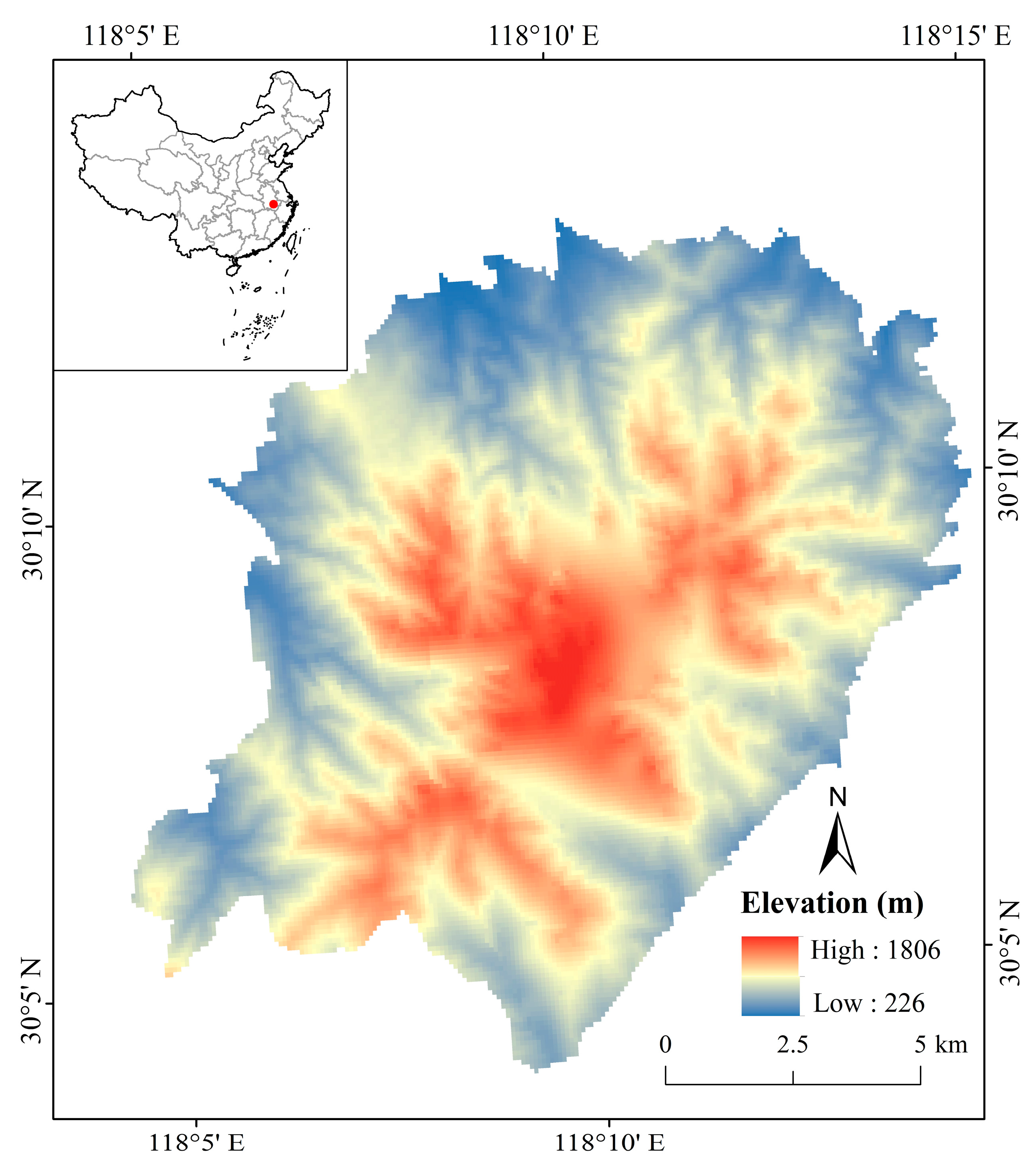
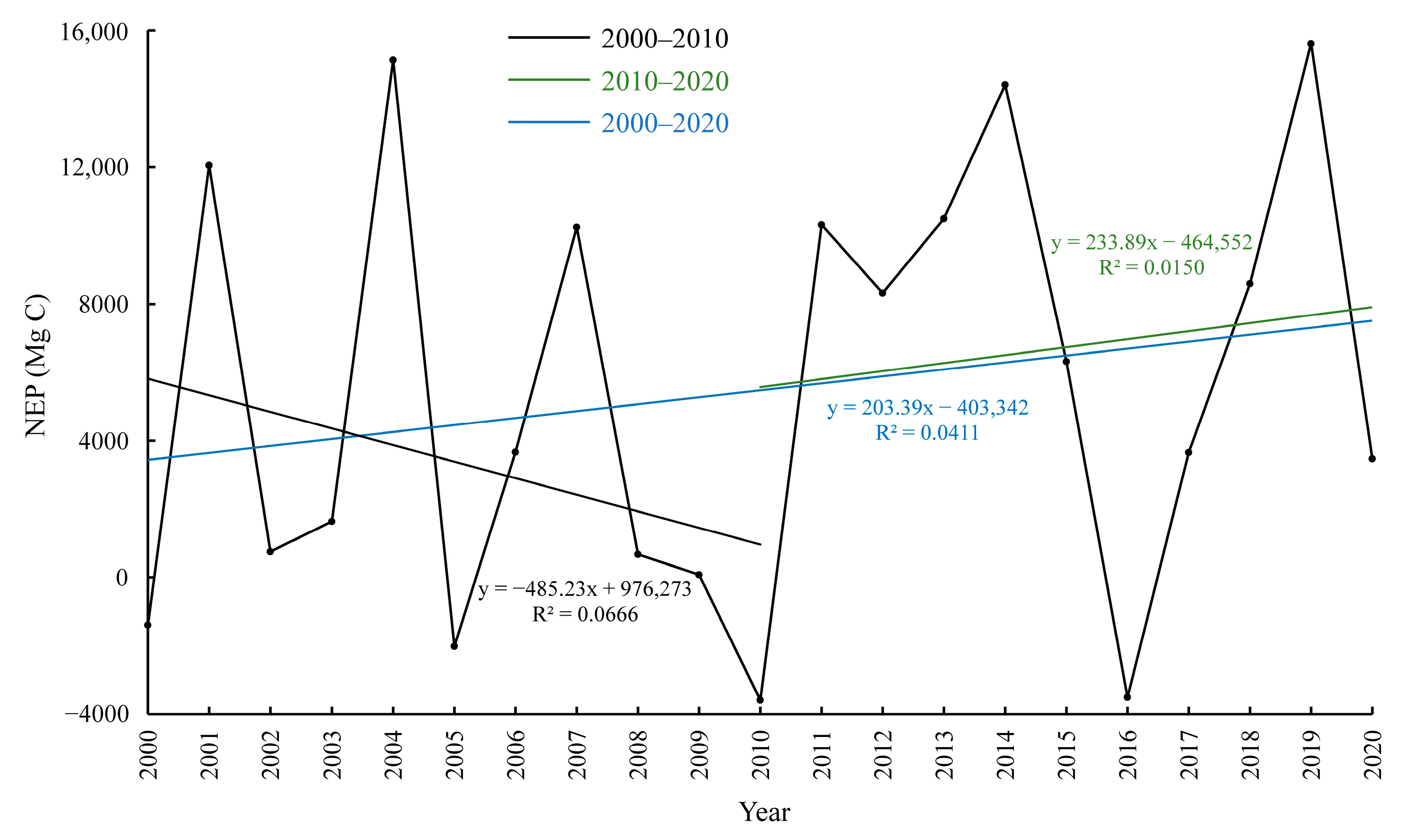
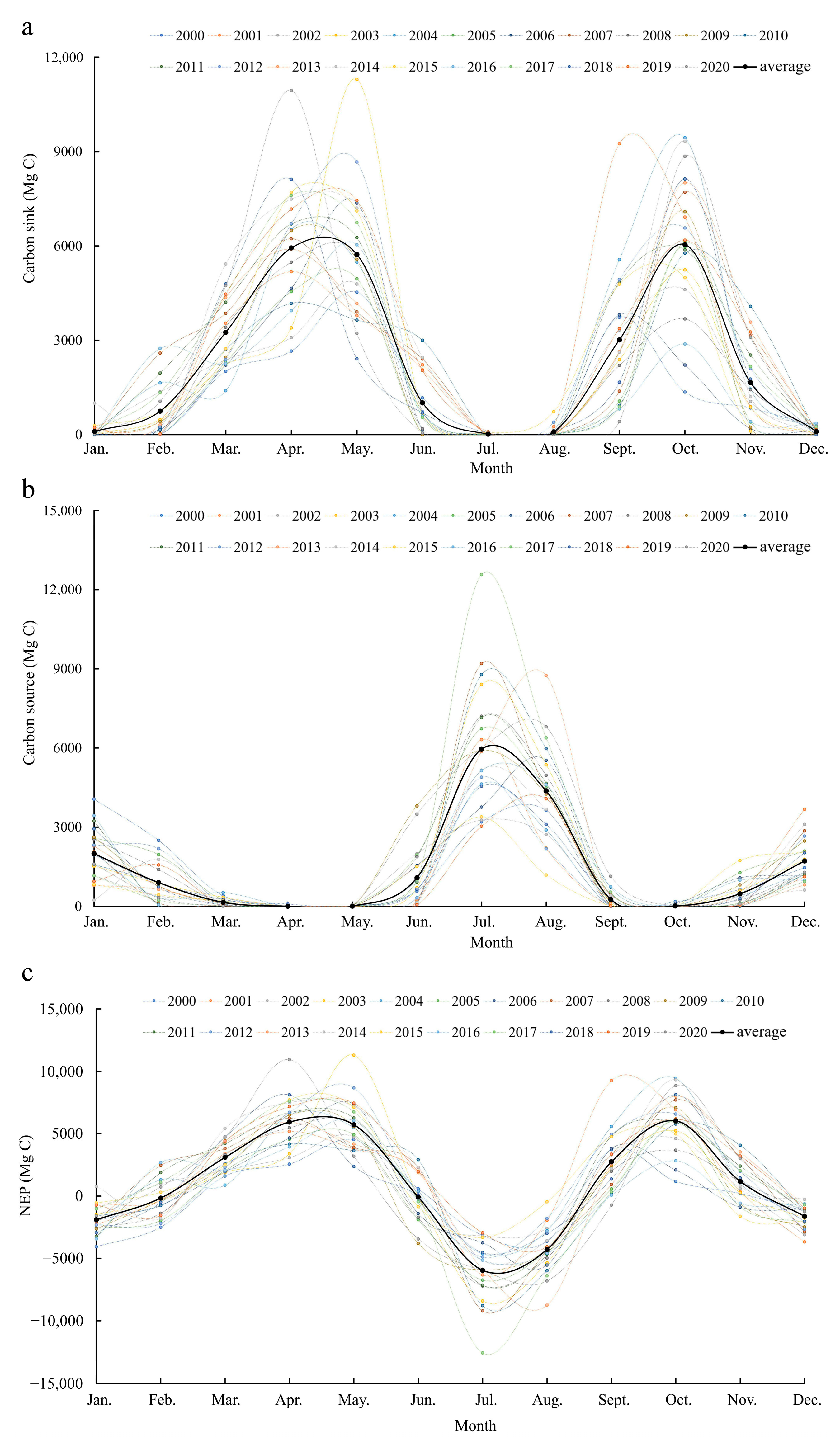

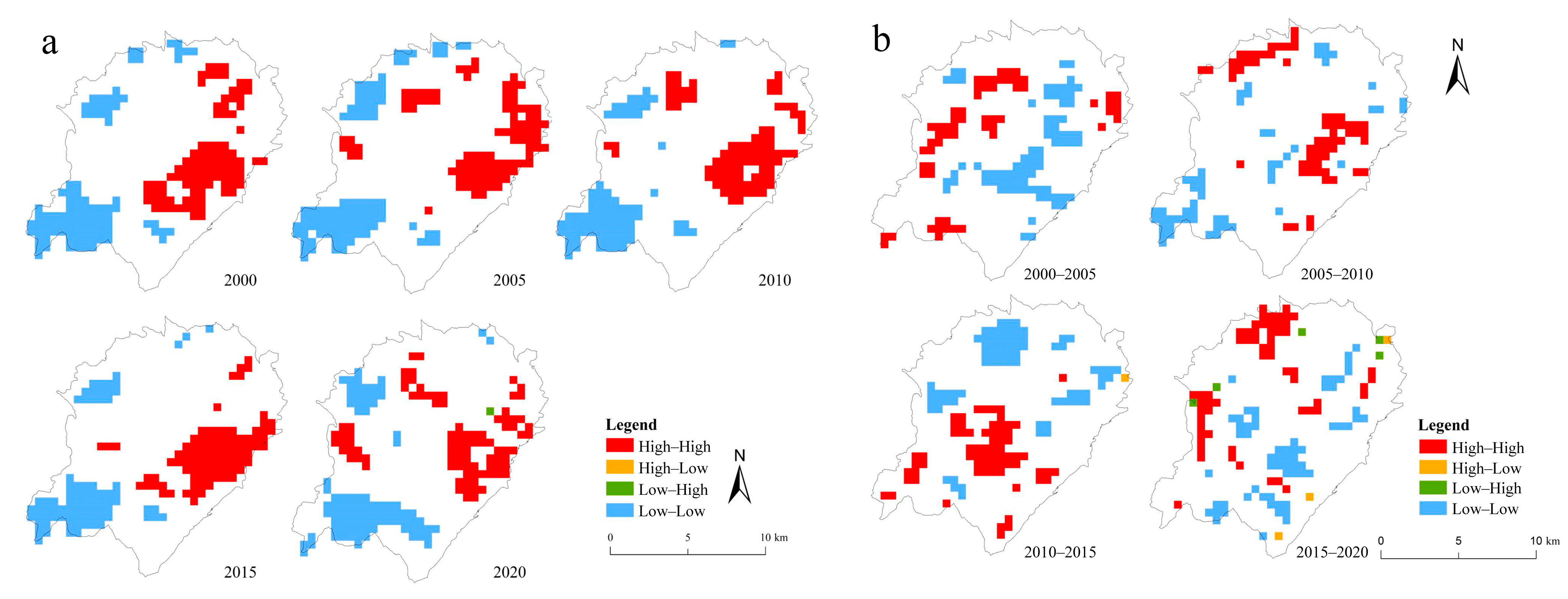
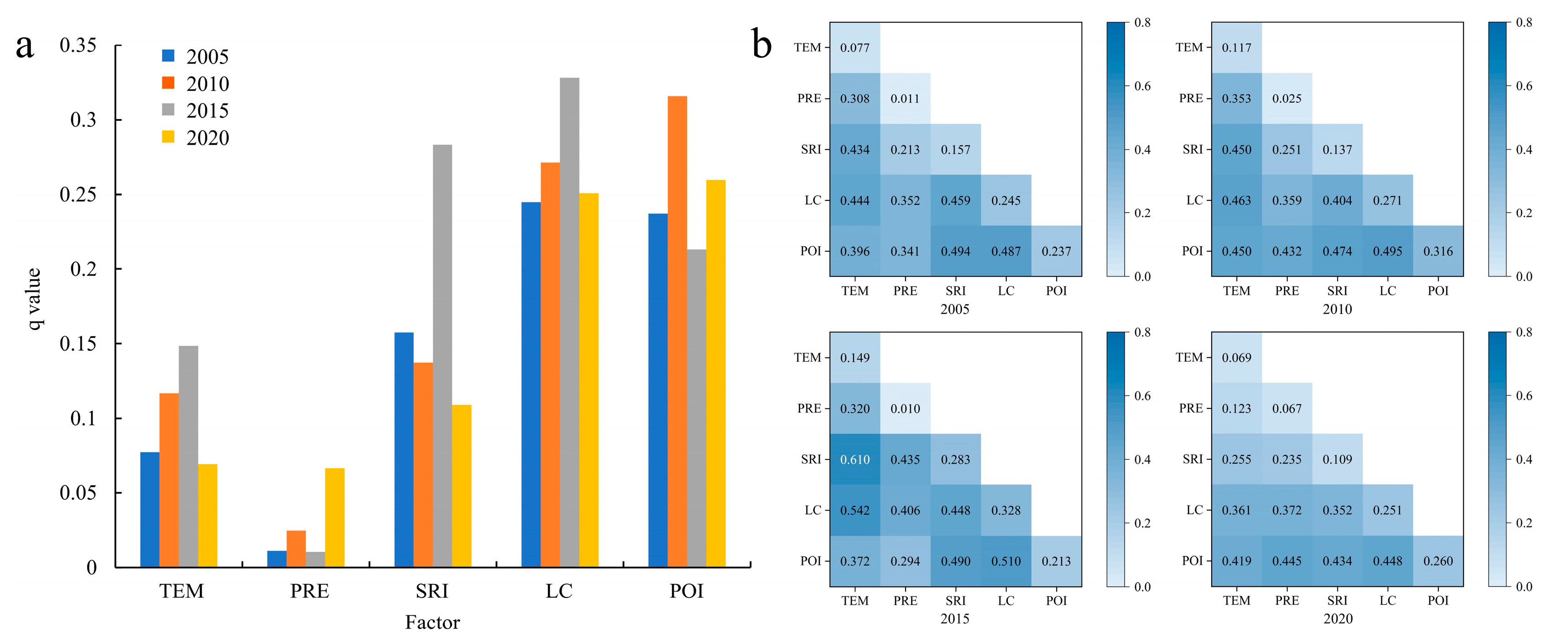
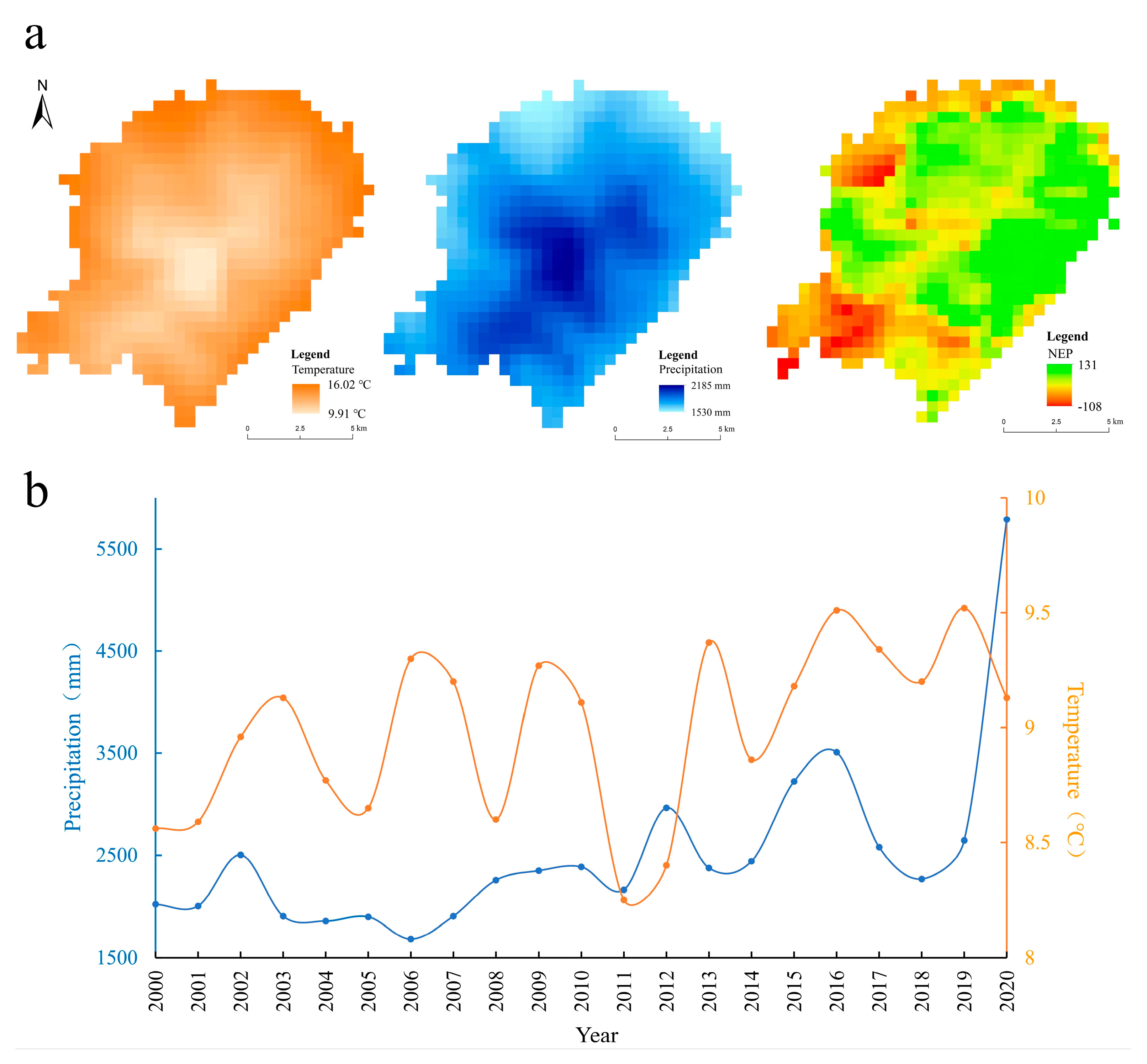
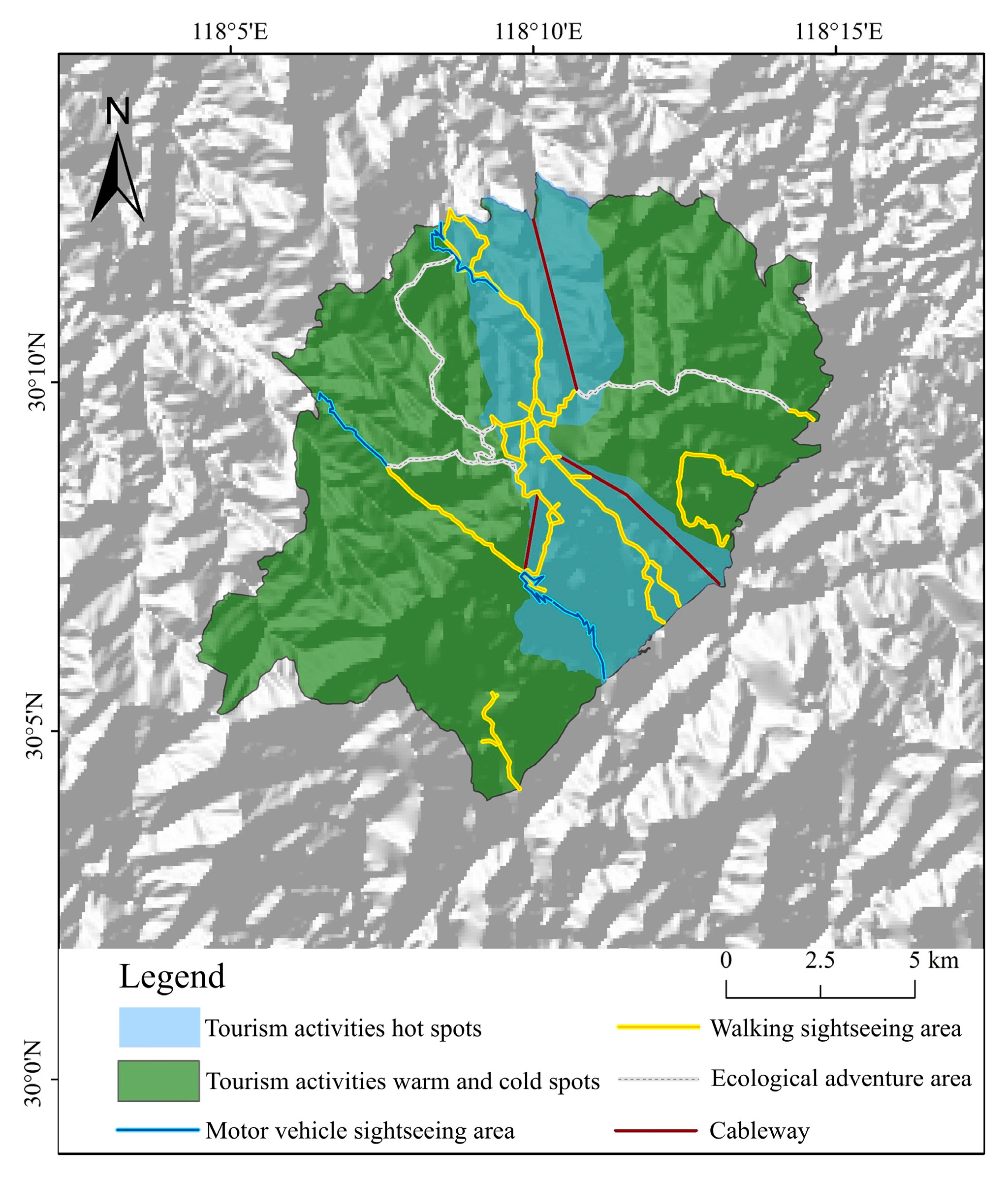


| Data Name | Data Sources | Resolution | Acquisition Time |
|---|---|---|---|
| NPP | USGS | 500 m | 2000–2020 |
| temperature | National Qinghai–Tibet Plateau Scientific data center | 1 km | 2000–2020 |
| precipitation | National Qinghai–Tibet Plateau Scientific data center | 1 km | 2000–2020 |
| solar radiation intensity | geographic remote-sensing ecological network platform | 500 m | 2005, 2010, 2015, 2020 |
| land cover | Earth System Science Data/GlobeLand30 | 30 m | 2005, 2010, 2015, 2020 |
| DEM | Geospatial Data Cloud | 30 m | 2000–2020 |
| Description | Interaction |
|---|---|
| Q(X1 ∩ X2) < Min(Q(X1), Q(X2)) | Nonlinearly weaken |
| Min(Q(X1), Q(X2)) < Q(X1 ∩ X2) < Max(Q(X1), Q(X2)) | Uni-weaken |
| Q(X1 ∩ X2) > Max(Q(X1), Q(X2)) | Bi-enhance |
| Q(X1 ∩ X2) = Q(X1) + Q(X2) | Independent |
| Q(X1 ∩ X2) > Q(X1) + Q(X2) | Nonlinearly enhance |
| Type | Factor | Meaning |
|---|---|---|
| Natural condition | TEM: temperature/°C | Mean annual temperature |
| PRE: precipitation/mm | Mean annual precipitation | |
| SRI: solar radiation intensity/W m−2 | Annual solar radiation intensity | |
| Human activity | LC: land cover | Land cover |
| POI: scenic spot tourism POI | POI kernel density |
Disclaimer/Publisher’s Note: The statements, opinions and data contained in all publications are solely those of the individual author(s) and contributor(s) and not of MDPI and/or the editor(s). MDPI and/or the editor(s) disclaim responsibility for any injury to people or property resulting from any ideas, methods, instructions or products referred to in the content. |
© 2024 by the authors. Licensee MDPI, Basel, Switzerland. This article is an open access article distributed under the terms and conditions of the Creative Commons Attribution (CC BY) license (https://creativecommons.org/licenses/by/4.0/).
Share and Cite
Hu, Q.; Zhang, J.; Xue, H.; Wang, J.; Li, A. Spatiotemporal Variations in Carbon Sources and Sinks in National Park Ecosystem and the Impact of Tourism. Sustainability 2024, 16, 7895. https://doi.org/10.3390/su16187895
Hu Q, Zhang J, Xue H, Wang J, Li A. Spatiotemporal Variations in Carbon Sources and Sinks in National Park Ecosystem and the Impact of Tourism. Sustainability. 2024; 16(18):7895. https://doi.org/10.3390/su16187895
Chicago/Turabian StyleHu, Quanxu, Jinhe Zhang, Huaju Xue, Jingwei Wang, and Aiqing Li. 2024. "Spatiotemporal Variations in Carbon Sources and Sinks in National Park Ecosystem and the Impact of Tourism" Sustainability 16, no. 18: 7895. https://doi.org/10.3390/su16187895
APA StyleHu, Q., Zhang, J., Xue, H., Wang, J., & Li, A. (2024). Spatiotemporal Variations in Carbon Sources and Sinks in National Park Ecosystem and the Impact of Tourism. Sustainability, 16(18), 7895. https://doi.org/10.3390/su16187895





